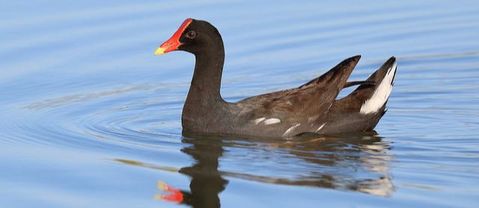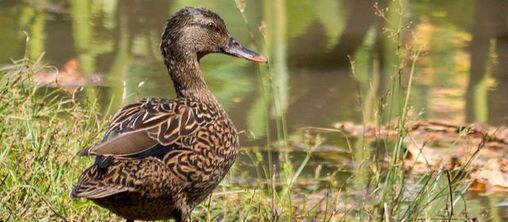Image above: An elevated view of Kawainui from the lo‘i field near Ulupō Heiau. (1)
|
Pānoanoa ka ‘āina, mānoanoa ka po‘e
Scarce is the land, many are the people (2) |
He aliʻi ka ʻāina, he kauā ke kanaka
The land is a chief; man is its servant (3) |
From a distance, it is easy to mistake Kawainui Marsh as a dry grassland lush with green vegetation. Upon closer inspection, however, we see that the illusion that we see today is actually due to the rich, dense vegetation found floating and surrounding most of the marsh, which itself is over a massive 800 acres (Drigot et al., 1982).
Where there is plants, there is almost always animals. Here we will focus on what specific flora and fauna communities are present and what factors allow them to thrive in Kawainui Marsh today.
Where there is plants, there is almost always animals. Here we will focus on what specific flora and fauna communities are present and what factors allow them to thrive in Kawainui Marsh today.
FLORA - VEGETATION IN THE KAWAINUI MARSH
Diana A. Lopera
Diana A. Lopera
Flora FLuctuationsHuman influence from as early as the arrival of ancient Polynesians has played significant roles in shaping the plant ecosystems present in Kawainui over the last thousand years (Anderson et al., 2017). From the introduction of new species to the establishment of complex irrigation systems, agriculture, and aquaculture, the advancements of the Ancient Hawaiian's society meant drastic changes for the the flora community (Drigot et al., 1982).
Figure 1 on the left shows a general schematic profile of plant distribution of a typical Hawaiian wetland in Hawai'i. |
PLANT COMMUNITIES
The vegetation found in Kawainui Marsh today can be characterized in four distinct plant communities (Drigot et al., 1982):
- GRASS COMMUNITY Kawainui Marsh's grassland community is dominated by the introduced California grass (Brachiaria mutica), a perennial grass that forms dense patches throughout the marsh. Other species include the honohono (Commelina diffusa), arrowhead (Sagittaria sagittaefolia), and scattered stands of the invasive weed cattail (Typha angustata).
- BULRUSH COMMUNITY This plant community is made up primarily of three species: bulrush (Scirpus californicus), sawgrass (Cladium Leptostachym) and taro patch fern (Cyclosorus interruptus). Bulrush thrive in wetlands such as Kawainui because its interior is made up of sponge-like air sacs, enabling it to extract the already limited oxygen from the water. If it does not take up too much of the space available in the marsh, the bulrush community can provide nesting and feeding grounds for a variety of animals.
- SHRUB AND TREE COMMUNITY This community exists around the edges of the marsh, surrounding the grass and bulrush communities. Species such as koa haole (Leucaena leucocephala), guava (Psidium guajava), Chinese banyan (Ficus microcarpa) and monkey pod (Samanea saman) make up most of this community. About 119 species live in this community, with about 8 of them native to Hawai'i (Smith 1978).
- OPEN WATER COMMUNITY This plant community is the smallest of the four, within the grass and bulrush communities in the marsh. It is made up of floating vegetation, one being the water lettuce (Pistia stratiotes). Its dark, dangling roots could potentially allow it to be a noxious invasive species, blocking vital waterways and could entangle small animals in the marsh.
fauna - endemic & Endangered water-birds found in kawainui marsh(4&9)
JACQUELINE MILLARD
The Hawaiian Islands once supported 113 unique bird species. Now, 71 of these species are extinct, with another 31 species being federally listed. The leading threats to Hawaiian birds include habitat degradation, nonnative predators, nonnative plants, and diseases. Kawainui Marsh is an essential wetland that encompasses 830 acres of land. Located in Kailua on O‘ahu, Kawainui Marsh provides an important habitat for four endangered species of native Hawaiian water-birds; The Hawaiian stilt, the Hawaiian coot, the Hawaiian common gallinule, and the Hawaiian duck. Thanks to the conservation efforts of preservation sites like Kawainui, these birds have a chance to recover their population before it is too late (10).
|
Hawaiian Common Gallinule (`Alae `ula) (5)
The Hawaiian common gallinule was listed as an endangered species in 1967. It experienced a drastic population declined as a result of destruction and degradation of its wetland habitat. The Hawaiian common gallinule population reached an all-time low in 1967 of just 13 birds statewide. Over the past 40 years their population has been gradually increasing, reaching a total of 363 in 2007 after its recovery plan was initiated. As of 2008, three Hawaiian common gallinules reside in Kawainui Marsh. Within Kawainui, the Hawaiian common gallinule has an estimated reproduction rate of 0.75 nesting pairs per acre per year. |
|
Hawaiian Duck (Koloa maoli) (6)
The Hawaiian duck was listed as an endangered species in 1967. Its population has been affected mostly by hunting, nonnative predators, hybridization with domestic ducks, and habitat loss. In 1967 the Hawaiian duck had an estimated population of 2,942 individuals. This number has since been declining, with a current population of around 2,000. In Kawainui Marsh there are roughly 9 Hawaiian ducks (as of 2008). Though it has been reported that Hawaiian duck has not experienced a significant change in its reproduction rate, Kawainui does provide them with foraging opportunities. |
|
Hawaiian Stilt (`A`eo) (7)
The Hawaiian stilt was listed as an endangered species in 1970. Due to habitat loss, predation, and hunting, the Hawaiian stilt's population notably decreased. is threatened primarily by habitat loss and predation. In 1941, the Hawaiian stilt population had declined to just 200 birds. In 1970, 525 Hawaiian stilts were counted across the state. Their population has increased since, reaching 2,103 birds in the winter of 2007. Currently, there are six Hawaiian stilts inhabiting Kawainui Marsh, where they have a reproduction rate of 0.65 nesting pairs per acre per year. |
|
Hawaiian Coot (`Alae ke`oke`o) (8)
The Hawaiian coot was listed as an endangered species in 1970. In the first half of the 20th century, the existence of the Hawaiian coot was initially threatened by hunting. More recently, however, the Hawaiian coot population has been significantly threatened by habitat loss. In 1970, the Hawaiian coot population dropped to a low of 208 birds but has since steadily increased its numbers to 1,763 as of 2007. There are around nine Hawaiian stilts found in Kawainui Marsh. The Hawaiian stilt has a reproduction rate of 0.2 nesting pairs per acre per year in Kawainui. |
References
- Lopera, Diana. "Kawainui Marsh." 2017. Photograph. Kawainui, Kailua, O‘ahu.
- “‘Ōlelo No‘eau .” apps.ksbe.edu/olelo/sites/apps.ksbe.edu.olelo/files/OleloNoeauSet3.pdf.
- “Nā ʻŌlelo Noʻeau.” oleloworkshop.weebly.com/uploads/2/4/0/7/24075835/ʻŌlelo_noʻeau.pdf.
- Center for Biological Diversity. “A Wild Success.” Apendix A: Population Trend Summary For All Threatened and Endangered Birds, June 2016, www.esasuccess.org/2016/pdfs/AWildSuccess_AppendixA.pdf.
- "Hawaiian Galliule". Flicker, Kahuku Aquaponds, Kahuku, Oahu, Hawaii, 12 Nov. 2016.
- Oliver, Ollie. “Hawaiian Duck.” Flickr, Hanalei NWR -- Ohiki Rd., Kauai Co, Hawaii.
- Liu, Peter. “Hawaiian Stilts.” Flickr, Kealia Pond National Wildlife Refuge, Maui, Hawai'i., 24 Jan. 2009.
- Parker, Glenn R. “Hawaiian Coot.” Flickr, 3 Mar. 2016.
- US Army Corps of Engineers. “Kawai Nui Marsh Environmental Restoration Project, Kailua, Island of O‘ahu, Hawai‘i .” Dec. 2008, pp. 1–283.
- “Kawainui Marsh.” Hawai‘i's Thousand Friends, www.hawaiis1000friends.org/kawainui-marsh.html.
- Elliott, Margaret E., Hall, E., and US Army Corps of Engineers. “Wetlands and Wetland Vegetation of Hawaii.” Earthwatch, Environmental Resource Investigators, 1977.
- Drigot, D., IS 489 Environmental Practicum Students, and Seto, M. "HO'ONA'AUAO NO KAWAI NUl (Educating About Kawai Nui): A Multi-Media Educational Guide". The Environmental Center University of Hawai'i, June 1982, pp. 128-138.
- Anderson, Brittany, Li Zhang, Huining Wang, Tianyi Lu, F. David Horgen, John Culliney, and Jiasong Fang. "Sedimentary Carbon and Nitrogen Dynamics Reveal Impact of Human Land-Use Change on Kawainui Marsh, O‘ahu, Hawai‘i." Pacific Science, 71.1 (2017): 17-27. Print.
- Smith, Linda. "Development of Emergent Vegetation in a Tropical Marsh." N.p.: n.p., 1978. N. pag. Print.










